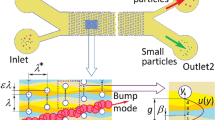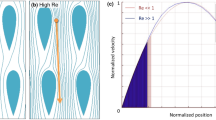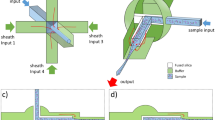Abstract
Recent progress in the development of biosensors has created a demand for high-throughput sample preparation techniques that can be easily integrated into microfluidic or lab-on-a-chip platforms. One mechanism that may satisfy this demand is deterministic lateral displacement (DLD), which uses hydrodynamic forces to separate particles based on size. Numerous medically relevant cellular organisms, such as circulating tumor cells (10–15 µm) and red blood cells (6–8 µm), can be manipulated using microscale DLD devices. In general, these often-viscous samples require some form of dilution or other treatment prior to microfluidic transport, further increasing the need for high-throughput operation to compensate for the increased sample volume. However, high-throughput DLD devices will require a high flow rate, leading to an increase in Reynolds numbers (Re) much higher than those covered by existing studies for microscale (≤ 100 µm) DLD devices. This study characterizes the separation performance for microscale DLD devices in the high-Re regime (10 < Re < 60) through numerical simulation and experimental validation. As Re increases, streamlines evolve and microvortices emerge in the wake of the pillars, resulting in a particle trajectory shift within the DLD array. This differs from previous DLD works, in that traditional models only account for streamlines that are characteristic of low-Re flow, with no consideration for the transformation of these streamlines with increasing Re. We have established a trend through numerical modeling, which agrees with our experimental findings, to serve as a guideline for microscale DLD performance in the high-Re regime. Finally, this new phenomenon could be exploited to design passive DLD devices with a dynamic separation range, controlled simply by adjusting the device flow rate.






Similar content being viewed by others
References
Aghilinejad A, Aghaamoo M, Chen XL, Xu J (2018) Effects of electrothermal vortices on insulator-based dielectrophoresis for circulating tumor cell separation. Electrophoresis 39:869–877. https://doi.org/10.1002/elps.201700264
Beech JP, Jonsson P, Tegenfeldt JO (2009) Tipping the balance of deterministic lateral displacement devices using dielectrophoresis. Lab Chip 9:2698–2706. https://doi.org/10.1039/b823275j
Chen Y, Abrams ES, Boles TC, Pedersen JN, Flyvbjerg H, Austin RH, Sturm JC (2015) Concentrating genomic length DNA in a microfabricated array. Phys Rev Lett. https://doi.org/10.1103/PhysRevLett.114.198303
Davis JA (2008) Microfluidic separation of blood components through deterministic lateral displacement. Princeton University, Princeton
Devendra R, Drazer G (2012) Gravity driven deterministic lateral displacement for particle separation in microfluidic devices. Anal Chem 84:10621–10627. https://doi.org/10.1021/ac302074b
Dincau B, Aghilinejad A, Kim J-H, Chen X (2017a) Characterizing the high reynolds number regime for deterministic lateral displacement (DLD) devices. Paper presented at the ASME international mechanical engineering congress and exposition, Tampa, FL
Dincau BM, Lee Y, Kim JH, Yeo WH (2017b) Recent advances in nanoparticle concentration and their application in viral detection using integrated sensors. Sensors. https://doi.org/10.3390/s17102316
Gilmore J, Islam M, Martinez-Duarte R (2016) Challenges in the use of compact disc-based centrifugal microfluidics for healthcare diagnostics at the extreme point of care. Micromachines. https://doi.org/10.3390/mi7040052
Henry S, Johnson E, Wen J (2015) SU-8 Delamination Resistance Study Report, 24 February, 2015 edn. University of Pennsylvania Scholarly Commons
Hou HW, Bhagat AAS, Lee WC, Huang S, Han J, Lim CT (2011) Microfluidic devices for blood fractionation. Micromachines 2:319–343. https://doi.org/10.3390/mi2030319
Huang LR, Cox EC, Austin RH, Sturm JC (2004) Continuous particle separation through deterministic lateral displacement. Science 304:987–990. https://doi.org/10.1126/science.1094567
Inglis DW, Davis JA, Austin RH, Sturm JC (2006) Critical particle size for fractionation by deterministic lateral displacement. Lab Chip 6:655–658. https://doi.org/10.1039/b515371a
Jiang ML, Mazzeo AD, Drazer G (2016) Centrifuge-based deterministic lateral displacement separation. Microfluid Nanofluid 20:10. https://doi.org/10.1007/s10404-015-1686-x
Jungbauer A (2013) Continuous downstream processing of biopharmaceuticals. Trends Biotechnol 31:479–492. https://doi.org/10.1016/j.tibtech.2013.05.011
Lee H, Lee K, Ahn B, Xu J, Xu LF, Woh K (2011) A new fabrication process for uniform SU-8 thick photoresist structures by simultaneously removing edge bead and air bubbles J Micromech Microeng. https://doi.org/10.1088/0960-1317/21/12/125006
Loutherback K, D’Silva J, Liu LY, Wu A, Austin RH, Sturm JC (2012) Deterministic separation of cancer cells from blood at 10 mL/min. Aip Adv. https://doi.org/10.1063/1.4758131
Lubbersen YS, Schutyser MAI, Boom RM (2012) Suspension separation with deterministic ratchets at moderate Reynolds numbers. Chem Eng Sci 73:314–320. https://doi.org/10.1016/j.ces.2012.02.002
Lubbersen YS, Dijkshoorn JP, Schutyser MAI, Boom RM (2013) Visualization of inertial flow in deterministic ratchets. Sep Purif Technol 109:33–39. https://doi.org/10.1016/j.seppur.2013.02.028
McGrath J, Jimenez M, Bridle H (2014) Deterministic lateral displacement for particle separation: a review. Lab Chip 14:4139–4158. https://doi.org/10.1039/c4lc00939h
Srinivasan B, Tung S (2015) Development and applications of portable biosensors. Jala 20:365–389. https://doi.org/10.1177/2211068215581349
Warkiani ME, Wu LD, Tay AKP, Han J (2015) Large-volume microfluidic cell sorting for biomedical applications. In: Yarmush ML (ed) Annual review of biomedical engineering, vol 17, pp 1–34. https://doi.org/10.1146/annurev-bioeng-071114-040818
Zeming KK, Salafi T, Chen CH, Zhang Y (2016a) Asymmetrical deterministic lateral displacement gaps for dual functions of enhanced separation and throughput of red blood cells. Sci Rep. https://doi.org/10.1038/srep22934
Zeming KK, Thakor NV, Zhang Y, Chen CH (2016b) Real-time modulated nanoparticle separation with an ultra-large dynamic range. Lab Chip 16:75–85. https://doi.org/10.1039/c5lc01051a
Zhang ZM, Henry E, Gompper G, Fedosov DA (2015) Behavior of rigid and deformable particles in deterministic lateral displacement devices with different post shapes. J Chem Phys. https://doi.org/10.1063/1.4937171
Acknowledgements
J.-H.K. acknowledges funding for this work provided by the New Faculty Seed Grant (131078) from Washington State University.
Author information
Authors and Affiliations
Corresponding author
Ethics declarations
Conflict of interest
The authors declare that they have no conflict of interest.
Additional information
Publisher’s Note
Springer Nature remains neutral with regard to jurisdictional claims in published maps and institutional affiliations.
Electronic supplementary material
Below is the link to the electronic supplementary material.
Rights and permissions
About this article
Cite this article
Dincau, B.M., Aghilinejad, A., Hammersley, T. et al. Deterministic lateral displacement (DLD) in the high Reynolds number regime: high-throughput and dynamic separation characteristics. Microfluid Nanofluid 22, 59 (2018). https://doi.org/10.1007/s10404-018-2078-9
Received:
Accepted:
Published:
DOI: https://doi.org/10.1007/s10404-018-2078-9




